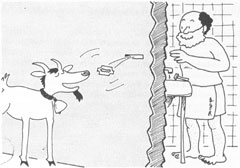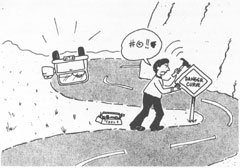Why do Clocks run clockwise? (16 page)
Read Why do Clocks run clockwise? Online
Authors: David Feldman

Submitted by Pat O’Conner, of Brooklyn, New York
.
WHY DO CLOCKS RUN CLOCKWISE? / 111
Why Does the Skin on the Extremities Wrinkle After
a Bath? And Why Only the Extremities?
Despite its appearance, your skin isn’t shriveling after your bath.
Actually, it is expanding.
The skin on the fingers, palms, toes, and soles wrinkles only after it is saturated with water (a prolonged stay underwater in the swimming pool will create the same effect). The stratum corneum—the thick, dead, horny layer of the skin that protects us from the environment and that makes the skin on our hands and feet tougher and thicker than that on our stomachs or faces—expands when it soaks up water. This expansion causes the wrinkling effect.
So why doesn’t the skin on other parts of the body also wrinkle when saturated? Actually, it does, but there is more room for the moisture to be absorbed in these less densely packed areas before it will show. One doctor we contacted said that soldiers whose feet are submerged in soggy boots for a long period will exhibit wrinkling all over the covered area.
Submitted by Michelle L. Zielinski, of Arnold, Missouri
.
112 / DAVID FELDMAN

What Happens to the Razor Blades That Are
Thrown Down Used-Blade Slots in Hotels?
Absolutely nothing. They are left to collect indefinitely between the studs of the walls. If you ever try to put a used blade down the razor slot and find the slot stuffed to the gills, you may assume that you are either in a very old hotel or in one that caters to a particularly hirsute clientele. Of course, there are fewer of those blades being deposited than there were years ago, because disposable razors are particularly popular among travelers; disposables won’t fit in the skinny opening.
If our civilization goes the way of the dodo and the remnants of our culture are buried in layers, we will certainly have some nasty surprises for future archaeologists. Between used razor blades and pop top can tabs, we will literally keep future diggers on their toes, or at least in very durable shoes.
WHY DO CLOCKS RUN CLOCKWISE? / 113
Why Doesn’t Evaporated Milk Have to Be
Refrigerated?
Evaporated milk, of course, is thickened solely by evaporation; it is often confused with condensed milk, which is made by evaporating some of the cow’s milk and adding sugar. Evaporated milk has a long shelf life because it is sterilized in the can, a steam-heat process that destroys potentially harmful microorganisms. Evaporated milk often develops a darkish off-color after about a year, but it is still safe to consume.
Submitted by Cassandra A. Sherrill, of Granite Hills, North Carolina
.
Why Is Evaporated Milk Sold in Soldered Cans?
Can openers, and the people who use them, have difficulty with soldered cans. Is there a real advantage to using them?
Soldered cans are stronger than regular aluminum or tin cans. As we have just learned, evaporated milk is actually sterilized in the can, and manufacturers have found soldered cans to be more dependable and durable during the intense heating process. Marsha McLain, of Pet, Inc., told us that all of their cans are welded with double seams in two pieces. The bottom and sides are actually one piece, and are filled with liquid. Only after the milk is put into the container is the top soldered on.
114 / DAVID FELDMAN
What Causes the Ringing Sound You Get in Your
Ears?
Unless you are listening to a bell, a ringing sensation means you are suffering from tinnitus. Someone with tinnitus receives auditory sensations without any external auditory source. While most of us rarely experience tinnitus, it is a chronic problem for over 30 million Americans.
Tinnitus is a symptom, not a disease in itself. Virtually anything that might disturb the auditory nerve is capable of causing tinnitus.
Because the function of the auditory nerve is to carry sound, when the nerve is irritated for any reason the brain interprets the impulse as noise.
Some of the most common causes for temporary tinnitus are: 1. Reaction to a loud noise.
2. Vascular distress after a physical or mental trauma.
3. Allergic reaction to medication. (Aspirin is the most common pharmaceutical cause of tinnitus. Many people who take more than twenty aspirin per day are subject to tinnitus attacks). Luckily, the symptoms usually disappear upon discontinuance of the drug.
Causes of more chronic tinnitus conditions are myriad. Here are some of the most common: clogging of the external ear with earwax; inflammation of any part of the ear; drug overdoses; excessive use of the telephone; vertigo attacks; nutritional deficiencies (particularly a lack of trace minerals); muscle spasms in the ear; infections; allergies.
Chronic tinnitus sufferers have to live not only with annoying buzzing, but usually with accompanying hearing loss. Unfortunately, there is no simple cure for the condition. Much research is being conducted on the role of nutrition in helping treat tinnitus, but for now, the emphasis is on teaching sufferers how to live with the problem. Devices are sold to mask the ringing sound. Techniques such as hypnosis and biofeedback are used to distract the patient from the annoying ringing.
WHY DO CLOCKS RUN CLOCKWISE? / 115
Ear problems may not be the most glamorous medical problems, but they are the most prevalent, as a booklet from the House Ear Institute, prepared by the Otological Medical Group, Inc., of Los Angeles, explains: “Loss of hearing is America’s largest, yet least recognized, physical ailment. More people suffer from it than heart disease, cancer, blindness, tuberculosis, multiple sclerosis, venereal disease, and kidney disease combined.”
Submitted by Bobby Dalton, of Maryland Heights, Missouri
.
How Did Chocolate Bunnies for Easter Come
About?
No doubt, the chocolate bunny was introduced for the same reason that candy corn was introduced for Halloween—in order to make more money for the candy industry. Purveyors of non-essential gift items (flowers, greeting cards, candy) are always looking for new reasons to compel customers to buy their products. If one were in-clined toward conspiracy theories, one could look on everything from Mother’s Day to National Secretary’s Week as nothing but blatant attempts to pry discretionary dollars from hapless citizens.
Chocolate bunnies date back to the 1850s in Germany. Along with bunnies, chocolatiers sold chocolate eggs and chickens.
Switzerland, France, and other European chocolate producers followed soon after. Most of the chocolate companies we contacted felt that the bunnies symbolized renewal and rejuvenation, and were intended to symbolize the “Rites of Spring,” not strictly Easter. As Charlotte H. Connelly of Whitman’s Chocolates told us, the chocolate bunnies spread rapidly to the United States from Europe.
At present, chocolate eggs and bunnies help bridge the “chocolate gap” that befalls the confectionary industry between St. Valentine’s Day and Mother’s Day.
116 / DAVID FELDMAN

Why Do Old Women Dye Their Hair Blue?
In the 1960s, it was fashionable to tint or bleach hair in pastel shades. Some older women, perhaps, are choosing to stick with a trend that has come and gone.
The majority, however, use a blue rinse (not a dye or tint) to combat the yellow shadings that discolor their gray or white hair.
Blue helps mask yellow.
Advancing age is not the sole reason for yellow hair. Some chemicals used in other hair preparations can cause yellowing. But the biggest culprit of all is smoke. Cosmetician Richard Levac told
Imponderables
that as we get older, the hair becomes more porous.
Smoke coats the hair and embeds itself in the hair shaft, causing yellowing.
Levac adds that very few women are intentionally trying to emerge from a salon with blue hair. Blue rinses are much lighter WHY DO CLOCKS RUN CLOCKWISE? / 117
than they were twenty years ago. If you can notice the blue, the hairdresser has done a poor job.
Ironically, blue hair has now made a comeback of sorts with young girls, thanks to new wave music. And with Cyndi Lauper around, any primary color is fair game.
Submitted by Daniel A. Placko, Jr., of Chicago, Illinois
.
118 / DAVID FELDMAN

What Are the Criteria for the Placement of a
“Dangerous Curve” or “Dangerous Turn” Sign?
The answer comes from the encylopedic
Manual on Uniform Traffic
Devices
. Individual states are free to deviate from the standards cited in this federal publication, but few do.
How do they determine if a turn is dangerous enough to warrant a warning sign? The
Manual
’s criterion for a turn sign (the black arrow at a right angle against a yellow background) is explicit: The Turn sign is intended for use where engineering investiga-tions of roadway, geometric, and operating conditions show the recommended speed on a turn to be 30 MPH or less, and this recommended speed is equal to or less than the speed limit established by law or by that regulation for that section of a highway.
Where a Turn sign is warranted, a Large Arrow sign may be used WHY DO CLOCKS RUN CLOCKWISE? / 119
on the outside of the turn. Additional protection may be provided by use of the Advisory Speed plate.
Note that these guidelines reflect the reality that actual traffic speeds usually exceed the law. Warning signs can be posted even if the
“safe” speed is identical to the posted speed limit.
The criterion for the curve sign is similar: a curve sign can be placed any time tests demonstrate that the recommended speed should be between thirty and sixty miles per hour and that speed is equal to or less than the posted speed limit.
Submitted by Robert J. Abrams, of Boston, Massachusetts
.
Why Don’t We Ever See Dead Birds?
We see hundreds of birds on an average day, and occasionally spot one run over by a car, but why don’t they ever see one dead from natural causes? Don’t they ever keel over in flight? Do birds go someplace special to die?
Surprisingly, birds don’t fly anywhere particular to die. The reason we don’t see dead birds is that they are quickly scavenged by other animals. Although this sounds like a cruel fate, bird expert Starr Saphir views it differently, marveling at the efficiency of the natural world. The moment a bird can no longer function, it is used as valuable fuel. Birds are eaten by cats, dogs, rats, opossums, small insects, and even bacteria. Saphir told us that she has led birdwatch-ing walks and seen the intact but dead body of a bird on the ground on the first leg of the walk; on the way back, an hour later, the majority of the body was already scavenged. Within twenty-four hours, the remains of most birds,
120 / DAVID FELDMAN
in the wild or in an urban area, would presumably become only a pile of feathers.
Richard C. Banks, vice-president of the U.S. Ornithologist’s Union, told
Imponderables
that a few birds might actually die in flight (although he had not personally ever seen this happen). The most likely candidates would be migrating birds flying over the ocean, far away from food sources and without convenient landing spots to fight off exhaustion. Sick birds generally don’t take wing in the first place.
